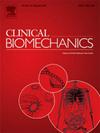Short-term effect of unicompartmental knee arthroplasty on muscle coordination in patients with knee osteoarthritis
IF 1.4
3区 医学
Q4 ENGINEERING, BIOMEDICAL
引用次数: 0
Abstract
Backgrouds
Over 60 % of knee osteoarthritis patients report experiencing the “giving way” phenomenon. This study aims to investigate the alterations in coordinated muscle contraction around the knee joint when the knee joint suddenly buckles under force, similar to “giving way”, in the patients before and after unicompartmental knee arthroplasty.
Methods
Twenty-five patients and 20 healthy adults were recruited to test the difference of muscle coordination between the patients before and about three months after surgery and healthy individuals. The self-designed force application equipment and a wireless surface electromyography system were used to collect the data on muscles activation when the legs were hit. The standard of significant difference was set as P < 0.05.
Findings
There were significant differences between the test and control groups in the directed co-contraction ratios of the hamstring/quadriceps(P = 0.016) and the co-contraction index of the quadriceps-hamstring(P < 0.001) on the affected side, as well as in the directed co-contraction ratios of the biceps femoris/vastus lateralis(P = 0.020) on the unaffected side. Compared with data before the surgery, in directed co-contraction ratios and co-contraction index there was only a significant difference in directed co-contraction ratios of vastus lateralis/vastus medialis on the affected side(P < 0.001) but there were significant differences in the co-contraction index of quadriceps-hamstring(P = 0.004) and vastus medialis-semitendinosus(P = 0.001) on the unaffected side after the surgery.
Interpretation
knee osteoarthritis affected the pattern of muscle co-contraction. In the short-term after the surgery, the co-contraction level in the affected side of patients did not have an obvious recovery but the activation level was improved, approaching healthy individuals.
单室膝关节置换术对膝关节骨关节炎患者肌肉协调性的短期影响
背景:超过60%的膝骨关节炎患者报告经历过“让位”现象。本研究旨在探讨单室膝关节置换术前后,膝关节在外力作用下发生类似“让位”的突然屈曲时,膝关节周围肌肉协调收缩的变化。方法选取25例患者和20例健康成人,检测手术前后3个月左右患者与健康人的肌肉协调性差异。利用自行设计的施力设备和无线表面肌电图系统收集腿部受撞击时肌肉的激活数据。显著性差异标准设为P <;0.05.结果实验组与对照组在腘绳肌/股四头肌定向共收缩比(P = 0.016)、股四头肌-腘绳肌共收缩指数(P <;0.001),以及未受影响侧股二头肌/股外侧肌的定向共收缩比(P = 0.020)。与术前相比,在定向共缩率和共缩指数方面,患侧股外侧肌/股内侧肌的定向共缩率差异有统计学意义(P <;0.001),但术后未患侧股四头肌-腘绳肌联合收缩指数(P = 0.004)和股内侧肌-半腱肌联合收缩指数(P = 0.001)差异有统计学意义。解释:膝关节骨性关节炎影响肌肉共收缩模式。术后短期内,患者患侧共收缩水平没有明显恢复,但激活水平有所提高,接近健康人。
本文章由计算机程序翻译,如有差异,请以英文原文为准。
求助全文
约1分钟内获得全文
求助全文
来源期刊

Clinical Biomechanics
医学-工程:生物医学
CiteScore
3.30
自引率
5.60%
发文量
189
审稿时长
12.3 weeks
期刊介绍:
Clinical Biomechanics is an international multidisciplinary journal of biomechanics with a focus on medical and clinical applications of new knowledge in the field.
The science of biomechanics helps explain the causes of cell, tissue, organ and body system disorders, and supports clinicians in the diagnosis, prognosis and evaluation of treatment methods and technologies. Clinical Biomechanics aims to strengthen the links between laboratory and clinic by publishing cutting-edge biomechanics research which helps to explain the causes of injury and disease, and which provides evidence contributing to improved clinical management.
A rigorous peer review system is employed and every attempt is made to process and publish top-quality papers promptly.
Clinical Biomechanics explores all facets of body system, organ, tissue and cell biomechanics, with an emphasis on medical and clinical applications of the basic science aspects. The role of basic science is therefore recognized in a medical or clinical context. The readership of the journal closely reflects its multi-disciplinary contents, being a balance of scientists, engineers and clinicians.
The contents are in the form of research papers, brief reports, review papers and correspondence, whilst special interest issues and supplements are published from time to time.
Disciplines covered include biomechanics and mechanobiology at all scales, bioengineering and use of tissue engineering and biomaterials for clinical applications, biophysics, as well as biomechanical aspects of medical robotics, ergonomics, physical and occupational therapeutics and rehabilitation.
 求助内容:
求助内容: 应助结果提醒方式:
应助结果提醒方式:


